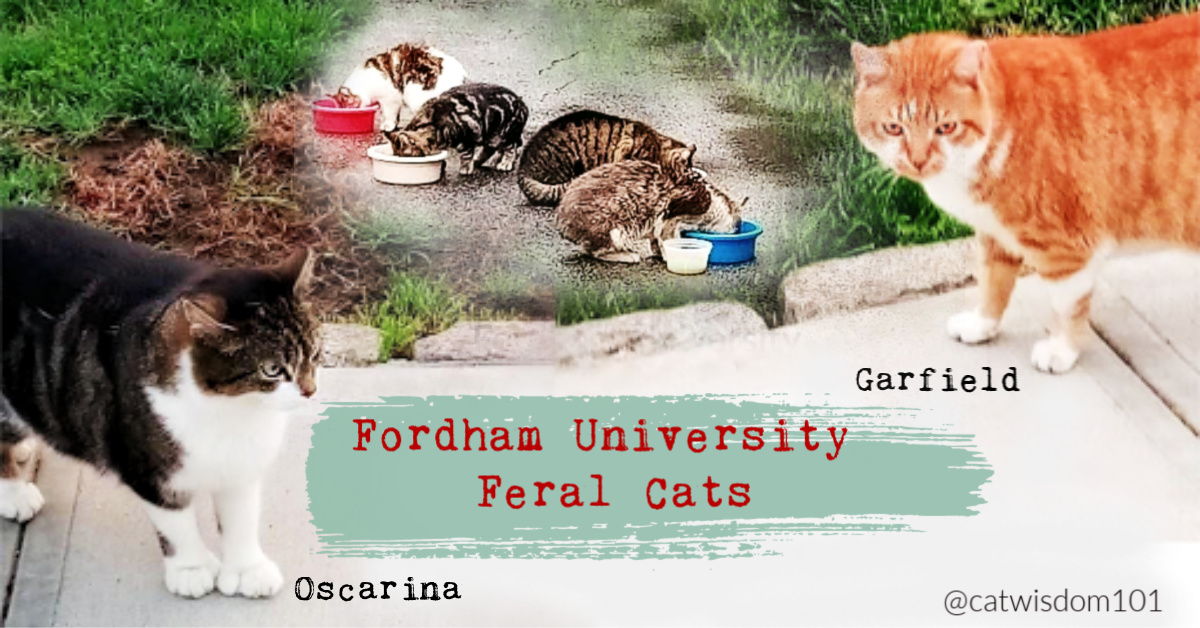
What you may not know about Feral Cats: Meet The Fordham Campus Cats
What you may not know about Feral Cats: Meet The Fordham University Ferals
by Layla Morgan Wilde
Feral cats live on most campuses but every college handles their presence differently. At the Fordham University campus in the Bronx, the cats are a welcome sight with some students photographing them and posting to the Fordham Cats Instagram account.
View this post on Instagram
A few students are interested in the day-to-day feeding of the ferals but most are busy with campus life. Thankfully the feral colony has been managed for years by dedicated volunteers Holly Malkasian and Roxanne Bonilla. It’s not without its challenges.
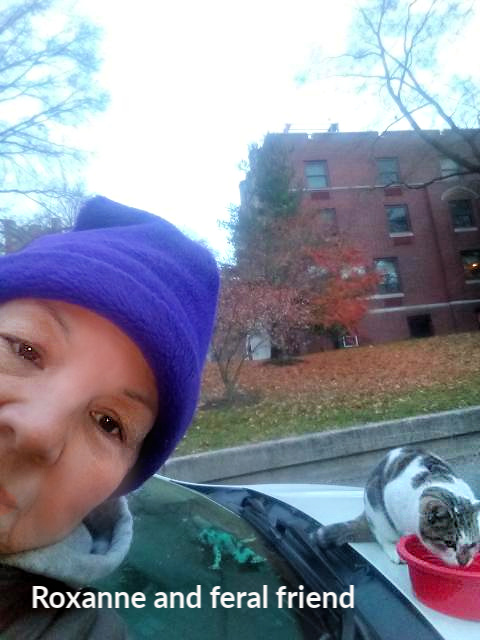
Many of our Cat Wisdom 101 readers volunteer at shelters, do rescue work of some kind including TNR. They are to me the everyday heroes the public doesn’t know. It’s all about the cats. They simply do their work with no time or interest to post their efforts on Instagram like some social media stars who rack up gazillions of likes and torrents of praise. They serve a valuable purpose but for every star there are thousands who work without recognition. Today, we shine on light on the quiet ones.
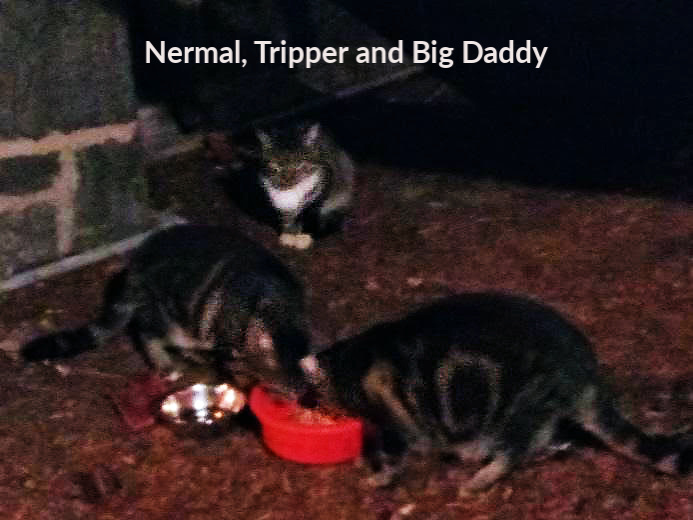
One of our readers, Roxanne Bonilla, is an unsung hero and I suggested she do a guest post. She demurred but helped me cobble together this post by taking some photos, added notes and assistance from Holly her cat rescue colleague for a unique look at feral cats.
Holly says, “It is completely managed except for the few newcomers that show up every once in awhile. Since it is an urban campus, there is no way to avoid that. When we do get a newcomer, we trap right away. What is frustrating is that the students post pictures and don’t pay attention at all if the cat is tipped even though I have posted many times and private messaged with the owner of the account that we need help on that. I know the school doesn’t want the kids to be too involved for liability reasons. Definitely trapping would be tricky because of the school’s hesitation but they could help with feeding, spotting newcomers, and even helping out with shelters.”
Feral Cat Adventures
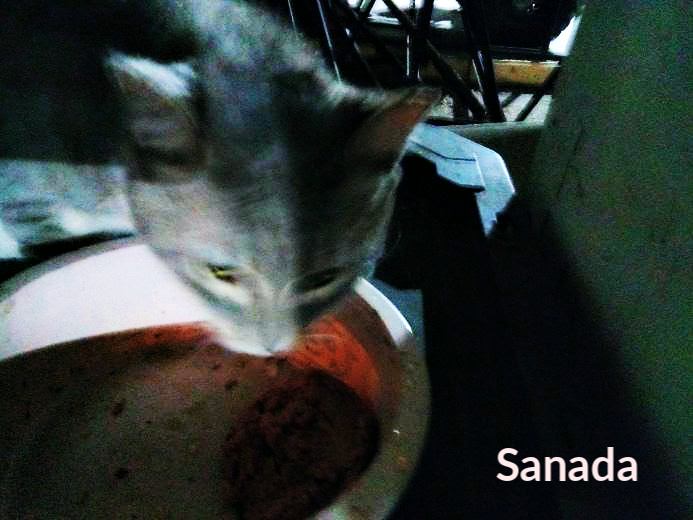
To spay/neuter a feral is routine but anything can happen before or after. It takes a certain kind of dedication to care for feral cats. Most cats dislike going to the vet but imagine a terrified feral trapped in a cage and transported in a vehicle probably for the first time. This is what happened to Sanada.
Roxanne says, “A student took Sanada to the Pet Receiving Center on Fordham Road because she thought he was sick. Sanada had been abused with telltale marks on his ears, tail. He walks with a limp and is otherwise he is okay. Pet Receiving is a satellite for NYACC in upper West Side, NYC. I called and asked to transport him back. They have a new program where he was neutered and vaccinated. ACC handed Sanada to me in a cardboard box but busted loose on a busy Manhattan street. He ended up at the Con Ed plant across the ACC where I spent 3 1/2 hrs on the ground calling him until he finally came and coaxed him into a large hard shell transport carrier.”
After Sanada’s wild adventure he prefers not to leave the basement garage level. He’s not especially friendly to his fellow residents like Tail-less but somehow all the cats work out their territorial differences.
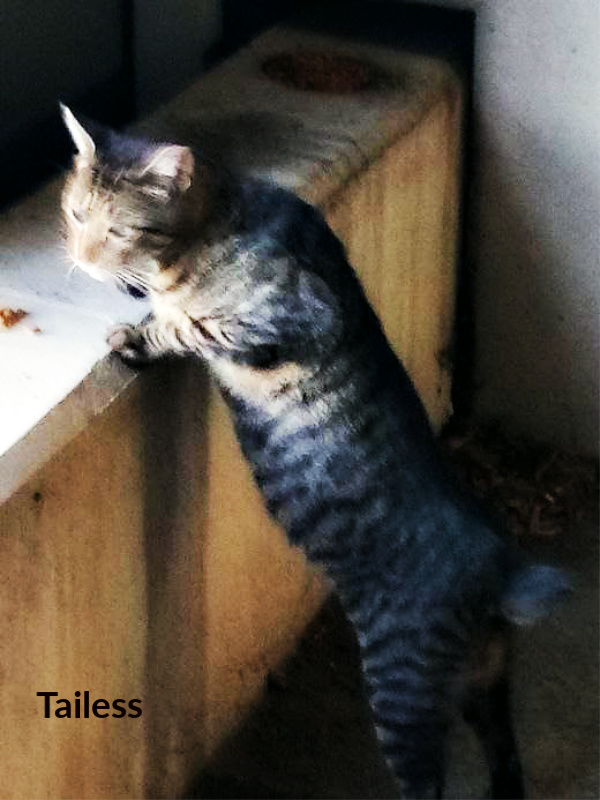
Tail-less (note the bobtail) is totally feral but a very loving kitty. “Tail-less when not keeping the garage mice/rat free watches people. He is not afraid but warns if they get too close. A few drivers have told me that since Tail-less roams freely, they slowed down tremendously while looking for parking. One person even said that once some paper fell from her bag and instead of walking away and leaving it on the ground thought that Tail-less was watching her litter and quickly tossed it in the garbage can.”
When He Was a She
This is Myra. Myra’s name is misleading. When first trapped as a youngster, I thought she was a female….NOT! Myra is the leader of the “White House” Colony and is extremely protective. Myra will swipe and warns other ferals not to get close to me. I cannot tell you how many times I have tripped over Myra. Myra loves to be petted while eating. At one time, we were pondering if Myra could be happy as an inside cat but after watching him closely decided against it.
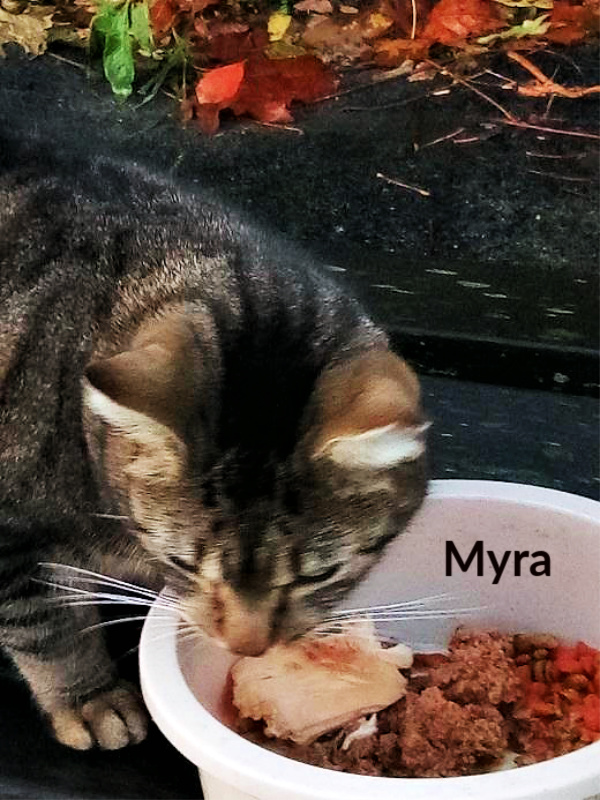
Roxanne continues, “This photo saddens me.
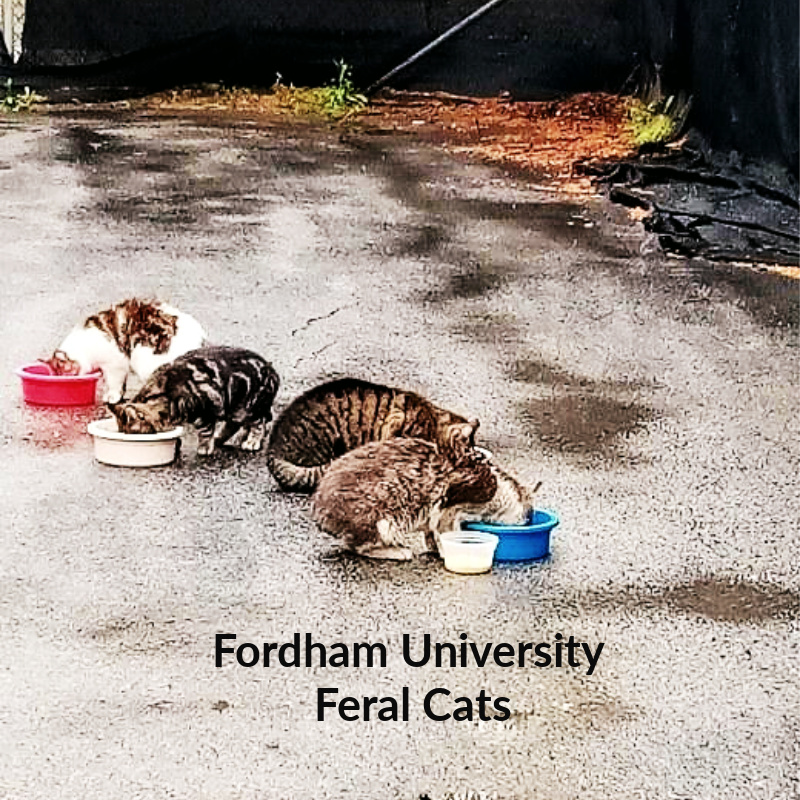
The grey and white is beautiful Nefertiti. The other grungy looking grey and white was Audrey. Before trapping, I didn’t know that Audrey was a boy but the name stuck. Audrey was old, deaf, almost blind and had teeth issues. Her dish was soft mashed food so he could eat. Despite Audrey’s issues, he was bonded with Nefertiti.
Nefertiti would give him cues when it was feeding time and when cars would be approaching. All the above cats and myself surrounded Audrey when he passed in August of 2019. The other two tabbies are Myra, the leader and his brother Mylo. Mylo passed in September after getting hit by a car. Mylo was becoming extremely friendly. I miss them terribly.
Once a feral, always a feral?
While most ferals are happy to remain feral, some can transition to domestic life. My own Domino, may he rest in peace, lived as feral for seven years and happily as a lap cat for 8 years. Friendly, socialized ferals can bridge the divide and sometimes get lucky like Iggy (seen here on his way to his new home.)
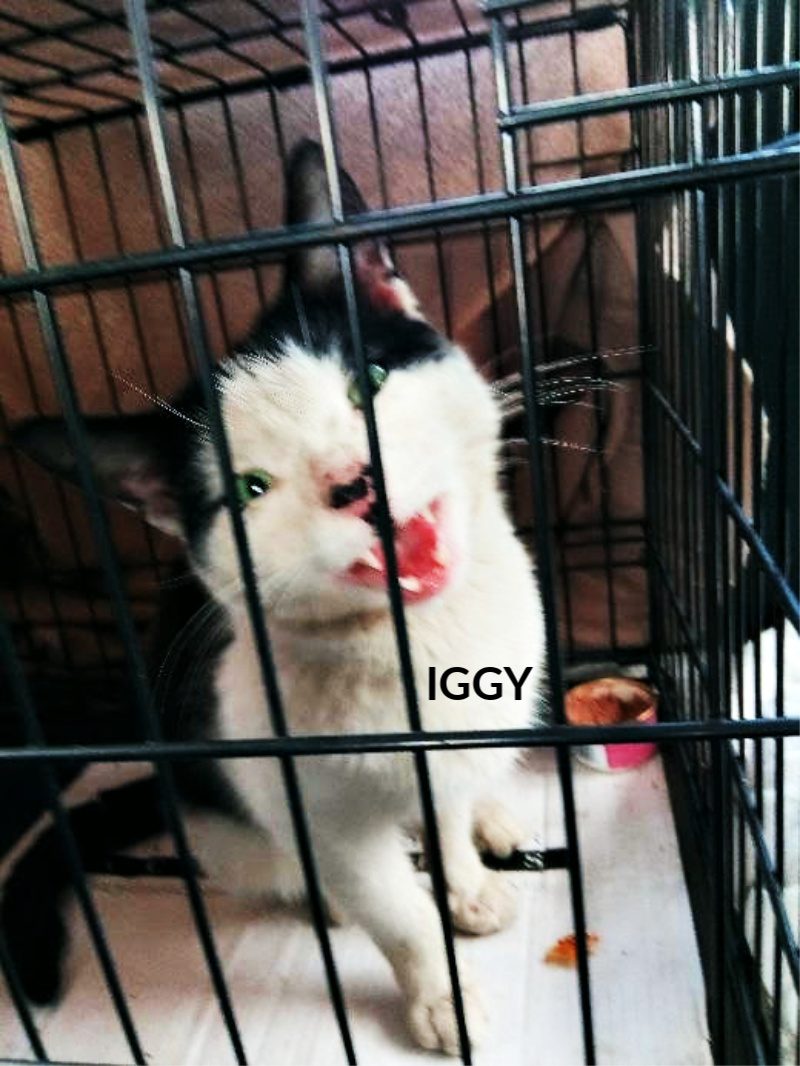
Roxanne says, “To date, we have had two ferals that have successfully been adopted and are living the dream.”
Iggy, named after the Statue of St. Ignatius is where he hung out near the Murray-Weigel building. Fordham is a Jesuit University and retired priests live in the building. The cats are identified by the campus building they live near i.e. Garage cats, White House cats, McGinley cats, Walsh library cats.
“Five cats hang out at Murray-Weigel and one day Security called about a cat that would not leave the front of the building. That was Iggy. After being restored to health, neutered & vaccinated, he was much too friendly of a kitty and was adopted. Iggy was one of the lucky ones.”
When is a feral not a feral?
By definition, feral cats or community cats are free-roaming, generally homeless domestic cats that live outdoors and are not socialized to humans. But there ferals who may have had a home once and prefer their own kind or been abused in that home and escaped. Feral cats tend to be fearful of humans because they weren’t socialized to human contact in the first 9 weeks of their lives. There are instances of socialized cats reverting to feral behavior after being abandoned or lost.
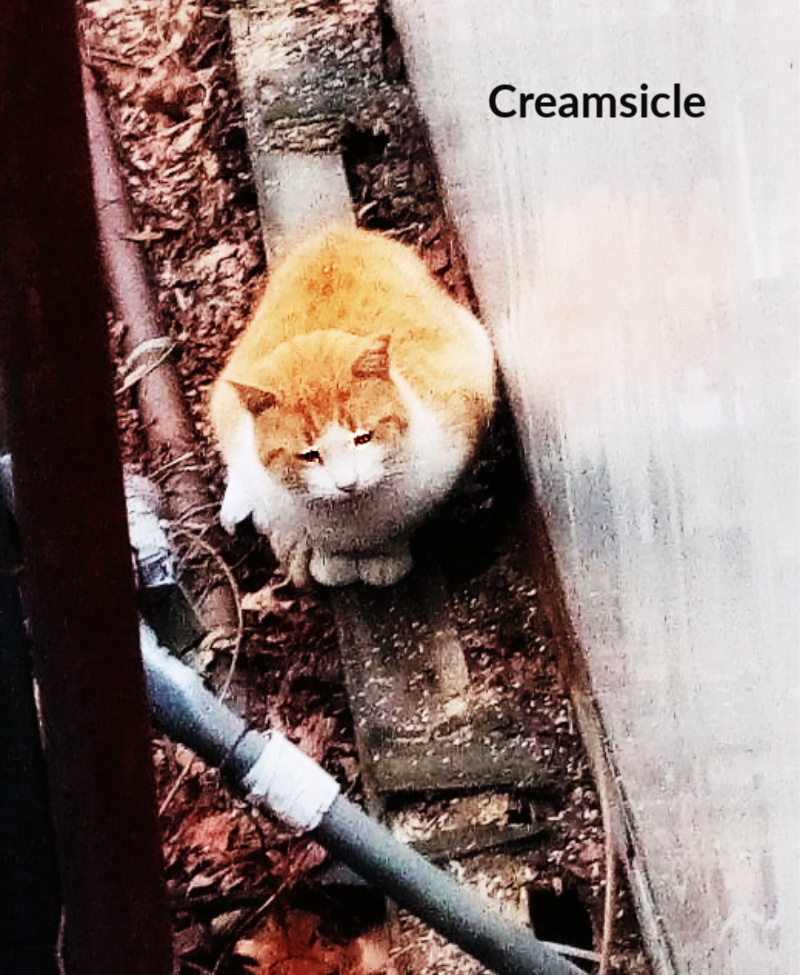
Creamsicle who goes by Cream, Chicago and who knows what else. The friendlier cats are up for petting and snuggles by a grab bag of students who invariably give each cat their own moniker. Roxanne says, “ Creamsicle is someone’s pet who prefers living with the colony. He looks great in this pic but before had a gash in his neck and foot. While undergoing TNR, he was giving meds and look how healthy he is now.”
Then there are cats like Black Mamba who are socialized, have a home but for whatever reason prefer to live in a feral colony.
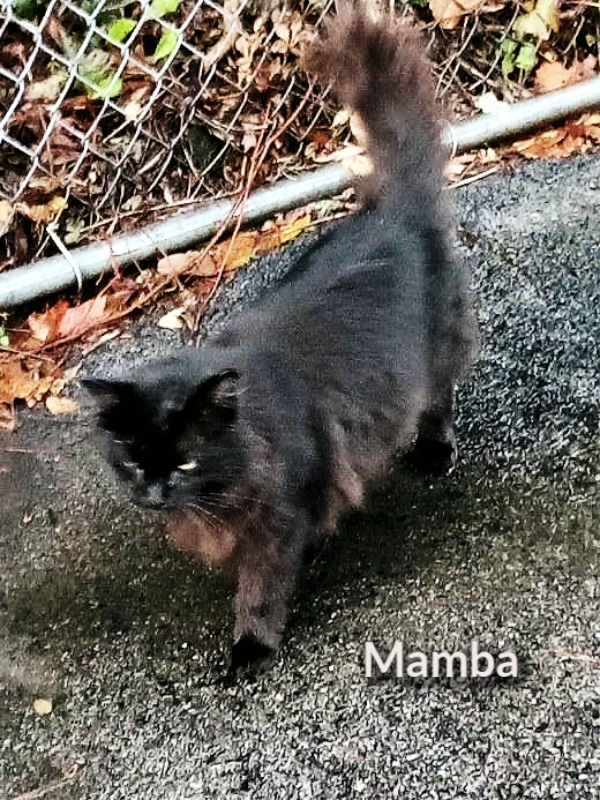
Roxanne says, “We named Black Mamba because as friendly as he is, if you try to walk away, he grabs hold and won’t let go of your leg. Black Mamba prefers women kitty and runs when he sees men. Black Mamba’s immune system is not the greatest. He is always with the “cat flu” but recuperates fast with medication.”
Why Help Feral Cats?
There as many reasons to care for feral cats as there are cats. For me it happened by accident 22 years ago, when there were a few ferals in the garden. I didn’t know they were feral. They just looked hungry, so of course I fed them and one thing led to another. I unwittingly launched a cat rescue group, changed careers and eventually became a cat expert.
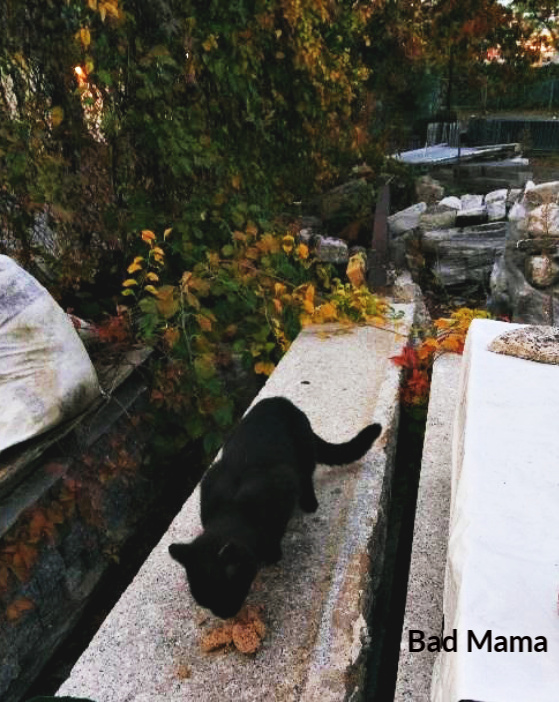
Caring for ferals is a passion. It’s an unpaid, often thankless job feeding, caring, trapping, transporting rain or shine 365 days a year. It’s not for the feint of heart. Most volunteers dig deep into their own pockets to buy food and supplies. They usually work full time at real jobs which means they have to get up earlier and/or stay up later to feed the cats. Die hard volunteers rarely take vacations since they are invariably short-staffed. Burnout is real. It happened to me and I no longer do hands-on rescue or feeding. It’s all the more reason the cats need more volunteers to pick up the slack.
Given the power of social media today, you may get hooked to the joys of helping feral cats by seeing the cute photos or reading stories about them like this. You may not have to go any further than your backyard. I’d suggest contacting your local shelter or rescue that have classes in TNRM (trap, neuter, return and monitor or manage) to learn best practices.
This is Holly’s story.
“I reluctantly took on the task of TNR at Fordham University. I live in Westchester County where there are plenty of feral cats to keep me busy. But about four years ago, I got trapped (pun intended) to go to the Bronx to help the cats on the campus. A friend’s daughter was a student at Fordham and she alerted me to the issue. I told her to find Bronx/NYC rescue groups but no one could help. Over fifty cats trapped, fixed, and vaccinated later, I am still involved with Fordham Campus Cats. Facebook page Fordham Campus Cats
View this post on Instagram
At first, I worked mainly alone. The cats were very difficult to trap and I was spending hours waiting on campus for them to take the bait. I found feeding stations where trays were piled with food so I knew the cats weren’t going to cooperate unless I located the feeders. I left notes at each location for the feeders asking them to contact me.
I sent out group emails, met the feeders and introduced them to each other. Most of the feeders didn’t know each other and some were feeding in the same locations at different times during the day. One feeder was feeding at 6:30am and the other at 7:30am at the same location. The second feeder was shocked, “The cats come running up to my car at 7:30 in the morning like they are starving!” I told her they were smart kitties and they were playing her for the extra food. Also, the cats had multiple names, “That is Snowball” one feeder said. “No, that is Charlie” another feeder said.
View this post on Instagram
Once when I was trapping at McGinley, a woman scowled at me as she walked past. I asked her if she wanted to ask me anything and she blurted out, “If you are hurting those cats, God is going to get you.” I laughed at the irony and she huffed away. I stopped her and explained what I was doing. I told her I was there to help the cats, not harm them.
View this post on Instagram
Roxanne is terrific and has taken over most of the work at Fordham. I still help her with the before/after care and assist if there is a problem with any of the cats. Recently Tug had a bad eye infection. Roxanne trapped him and I took him to a veterinary eye specialist (he was treated when he was neutered but his eyes were still severely infected so we needed to get him to a specialist). The medical facility of the eye specialist is new with sparkling white marble floors and modern clean lines. Tug was the only patient in a trap covered in an old towel. Sitting in the waiting area, I placed the metal forks that are used to corner him on top of the trap. The other owners gave us sideways looks and pulled their dogs close.
Fordham now has managed colonies and Roxanne really has a handle on any newcomers that need to be trapped. The cats have shelters and for the most part, the school is tolerant of them living on campus with the students. The cats also serve a purpose because they keep the rat and mouse population under control, an issue at any urban location.”
View this post on Instagram
The Fordham ferals receive more veterinary care than many ferals. The truth is most feral cats receive little to no vet care. The lucky ones are neutered and spayed but it’s difficult to administer meds to cats who don’t like being handled.
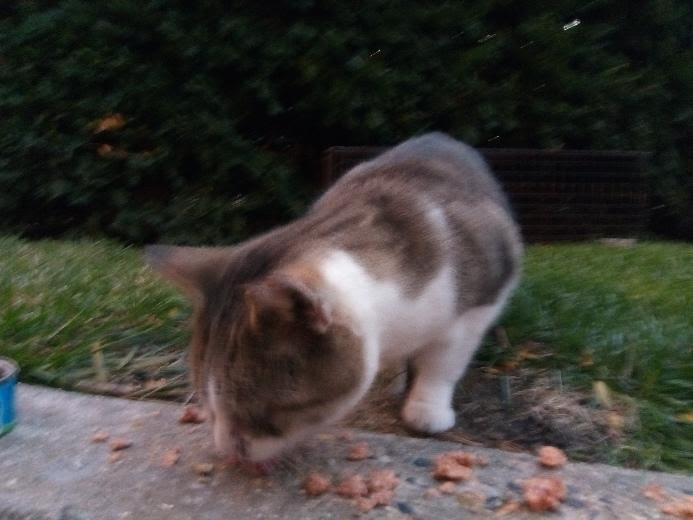
Meet Tug. “Tug has severe eye issues. Holly took him to a cat specialist to check whether he was blind. The issue is that Tug’s tear ducts are clogged. Surgery with inserting a permanent tube and wearing a cone for a few months was just not in the cards for this feral. The vet cleaned his eyes, gave meds and said he could see. Tug’s eyes will always look raw and runny.
Love, Feral Style
View this post on Instagram
Garfield the ginger lives with a tabby named Oscarina. They are a bonded pair often photographed curling up together perhaps to stay warm. Roxanne says, “Garfield is a very fussy eater and will only eat Friskies wet and dry food. As big as Garfield is he could race up and down a willow tree at McGinley. There is a bird that use to dive bomb him every morning. Instead of trying to catch the bird, Garfield paid no attention to the bird pecking away at him….remarkable.”
Take the leap to help the Fordham Ferals. Live near campus or quick subway ride away? Email me and I’ll contact Roxanne and Holly. Serious inquiries only info@catwisdom101. Please write Fordham ferals in subject line.
View this post on Instagram

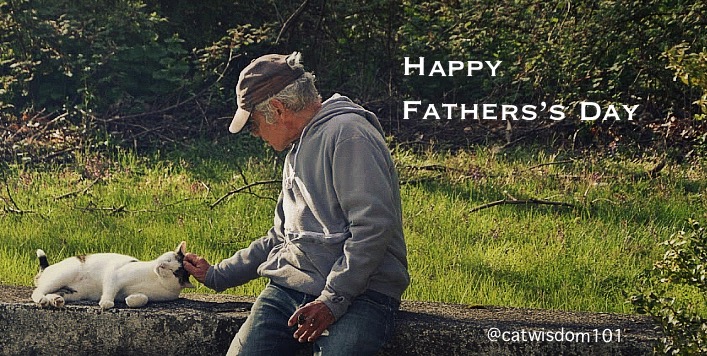

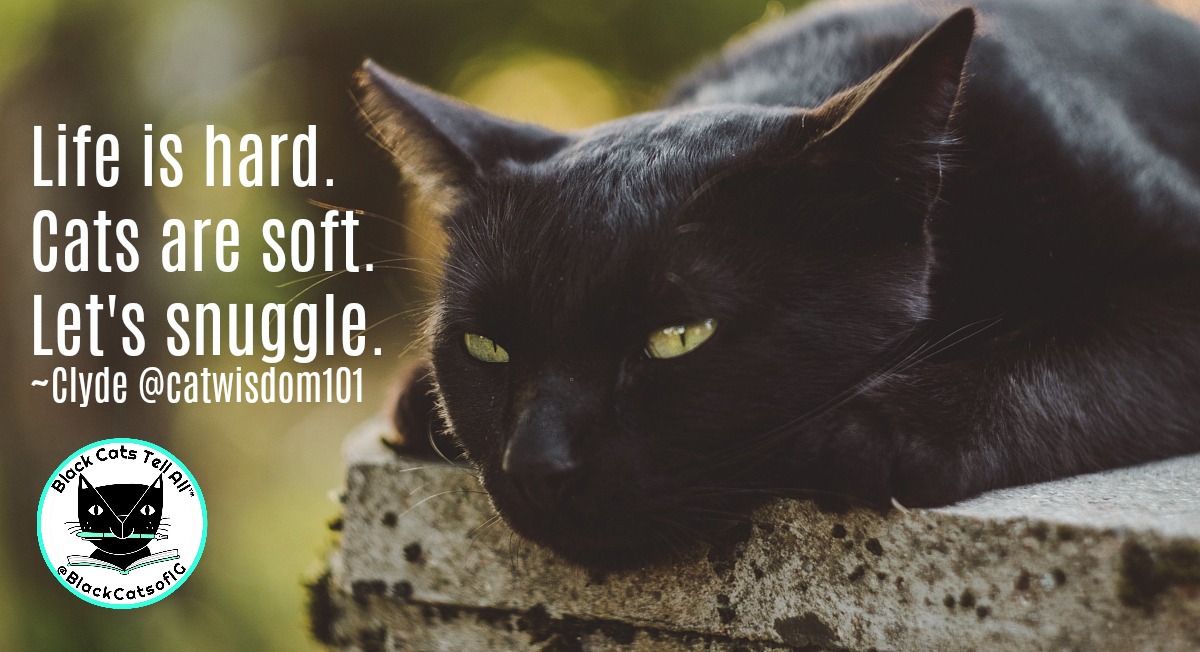
12 Comments
Cat Tower
QQ
Timmy Tomcat
What a great post and thanks so much for educating on Feral Cats. I just found some under my shed and luckily got them all trapped in a little over a week. The kittens are getting forever homes while mom and dad, who seem like scared abandoned cats and not really feral, are on their way to a home to be socialized and hopefully their own forever homes. We love ferals and those who care for them!
Layla Morgan Wilde
thank you so much for trapping ferals and finding the kittens homes!
Meezer'sMews&TerrieristicalWoofs
Wow! Enough said:)
Thanks to those ladies!
When we first were married there were lots of wandering cats about the area, but now we hardly see any except inside house windows. Phew…at least for now.
Andrea
I think caring for ferals is a calling. I was called three times, three colonies, but now those colonies are gone. Unfortunately a neighbor just informed me that there is a new mother and her kittens hanging around the neighborhood. I wasn’t looking to get into another colony. Sigh.
Great article. Much needed info.
Layla
Thank you Andrea for suggesting it’s a calling. It’s funny how opportunities present themselves 😻
Skeeter and Izzy
This is a great article that gives some insight into the down and dirty on caring for Feral Cats. It is often times exhausting, thankless, expensive WORK, but it is work that those of us that do it, do it with love, determination and devotion.
Some of my friends often times do not understand why I always put my cats ahead of other things and always insist on caring for them before I do anything else or go anywhere. It is a passion and those of us that do it understand that the cats have to come first. We make a commitment to them whenever we put out the first serving of food or make the first introduction with the “Well hello there beautiful” comment. They do not ask to be in the circumstances that they are in. We know them inside and out after a while and they become yet another part of our families. We love them, we feed them, we spay and neuter them, we medicate and provide vet care for them, we shelter them, we talk to them and we grieve for their passing with great intensity. I try to spend as much time as possible with them working on socialization if only with me.
I do get up at 4 am to be able to feed my colonies and care for my indoor kitties before going to the full time job. I do go out as soon as I get the food ready when I get home in the evening no matter if it is midnight, 365 days a year no matter the temperature, precipitation, or wind chill. My kids have to eat and drink the same as me .
People often ask why I don’t just do so and so (miss feeding etc.) and I simply tell them that I made a commitment and I will honor that as long as I am physically and mentally able to, the same as if I had made that commitment to a human (these days more so)
My cats are not just a part of what I do they are a part of who I am,
Thank you to everyone that does this kind of work and to anyone that does not understand it just give someone that does a gift card or money or a bag of cat food and a hug and maybe one day you will. If we ask for cat food for Christmas by all means please oblige because we truly mean it when we say that is what we want.
Luvs to all
Skeeter and Izzy and the Feral Gang >^..^<
Layla
Thank you so much for your added insights and commitment. Beautifully said as always.
Jayme Beall
The director and co-founder posted this on her page Operation CatSnip of the Treasure Coast here in Florida director. I really enjoyed your article and I am glad to see so many people caring for the kitties. I loved the part about 2 people feeding at the same places at different times and also the 2 names for the same cat.
I have the same issue with the names. I currently care for a colony of about 30 ferals, most are kittens (under age of 6months) and I was nervous about having so many kittens. All the cats, around 60 were taken from a hoarding situation. Some were pregnant, just had babies or needed special care. The ones that could be TNVR were brought back to the same woods were their bloodlines originally started. I try and get good pictures so I can distinguish between them because their markings look so much alike (calicos and tuxedos mainly).
I have a friend that donated material that I can build weather resistant shelters (about 6-8 ft long) and hopefully in the next few weeks we will have all 3 triangle shaped shelters completed with multiple entries, shingle roofs and comfortable bedding. Even though Florida dosen’t get cold often and their habitat is in a heavily wooded area they still need shelter if anything just to feel safe.
Being a volunteer or an advocate is a fulltime job with no monitary pay but the real payoff is greater than money. I am lucky to have been at the right place at the right time and the time to do what I do. I can sit from my porch, see my feeding stations and watch the kittens especially frolic and play after breakfast and afternoon feeding. Afternoons I take time and sit with and work with them with toys and such. My hope is to get at least one to a fur ever home.
Thank you for your article.
Laura
The comment, “it is difficult to give meds to cats that don’t like to be handled” made me laugh. I have a gentle giant of a cat, he weighed about 14 lbs and trying to give him meds was hilarious, he wouldn’t bite or scratch intentionally but he’d squirm and I feared harming him. I can’t imagine trying it with a feral. OMG they seem to develop extra limbs and become fluid!! Amazing work.
Beverly
Thank you for the super article!
Layla
Glad you liked it Beverly.